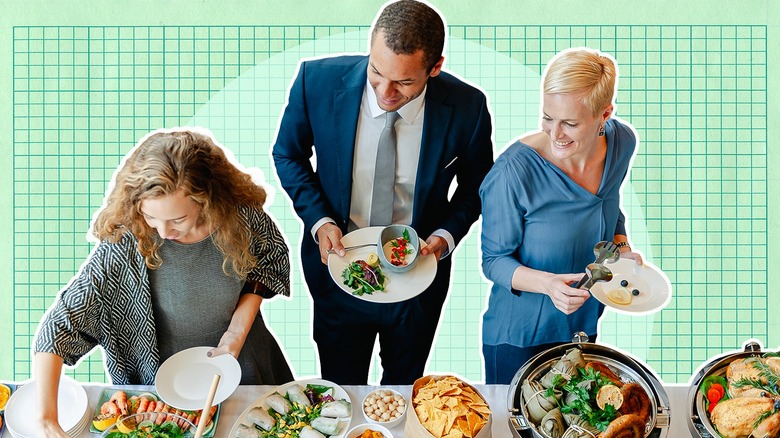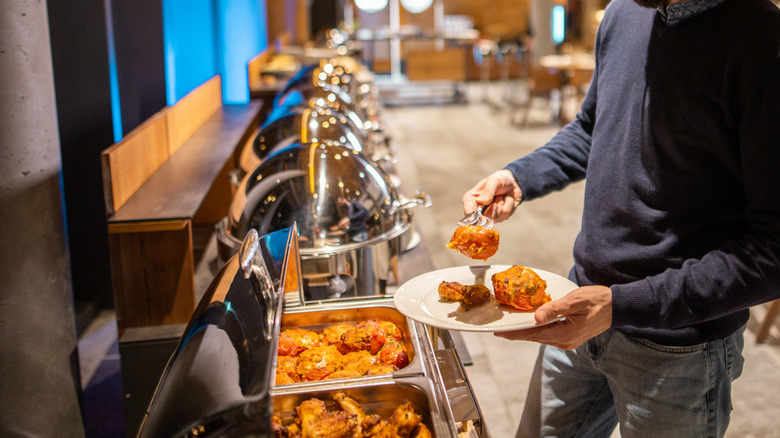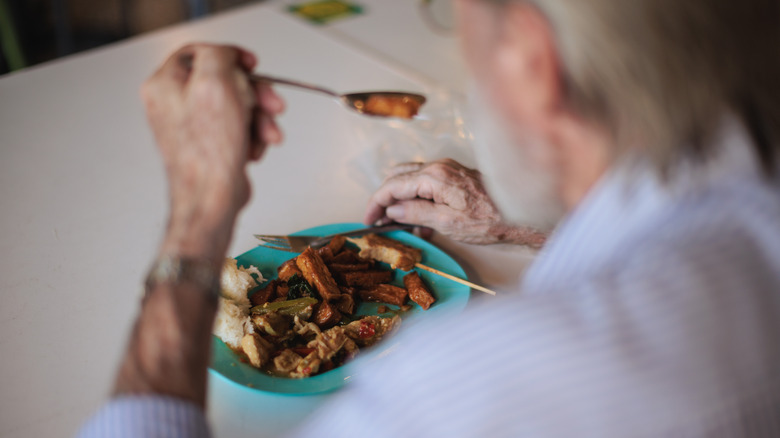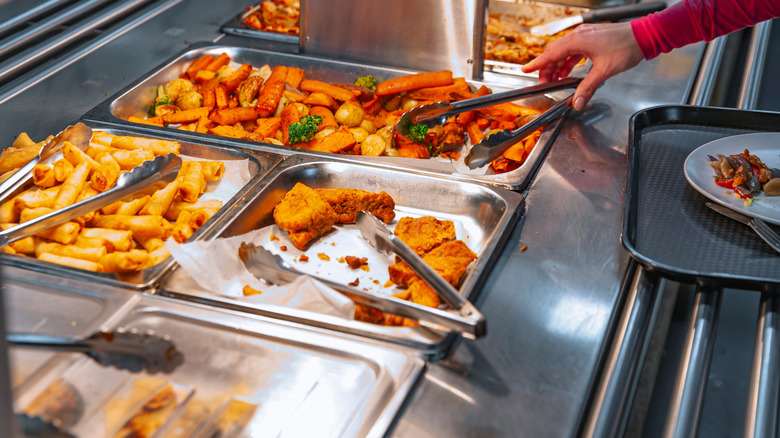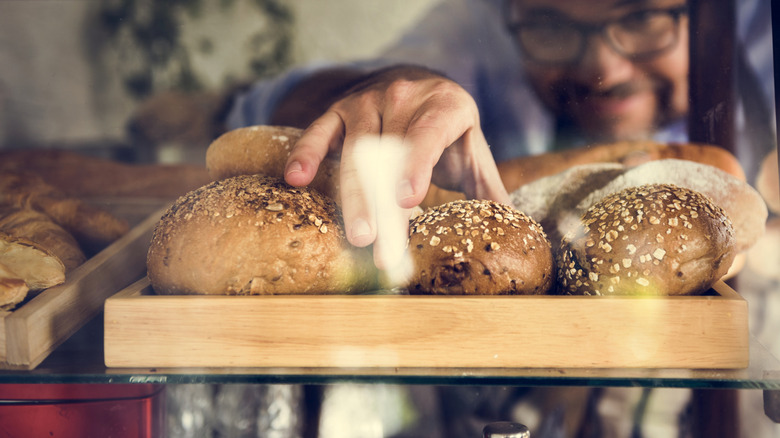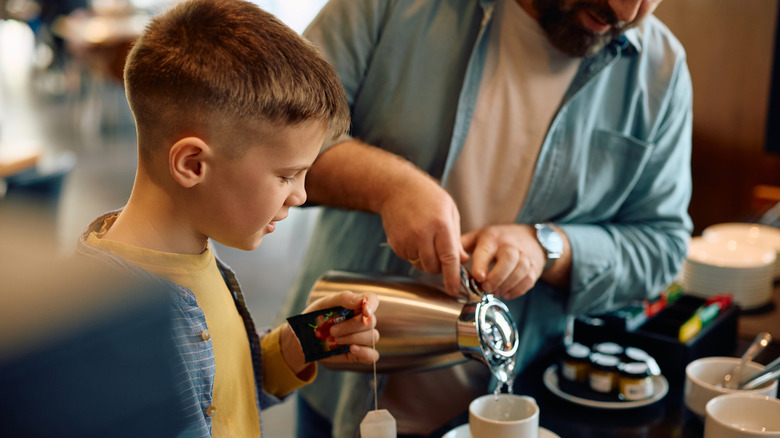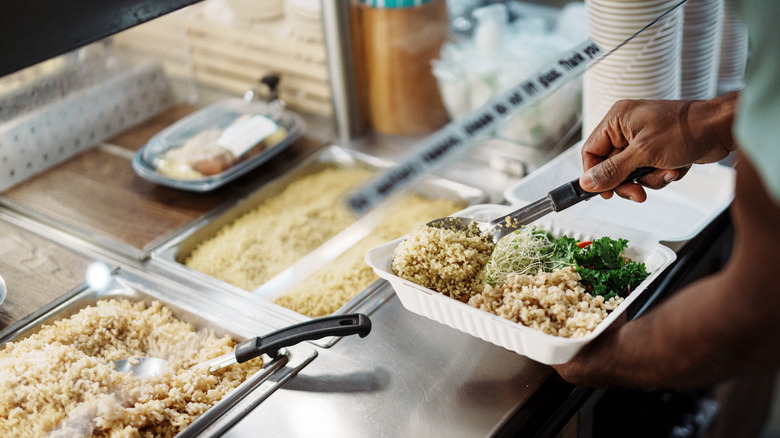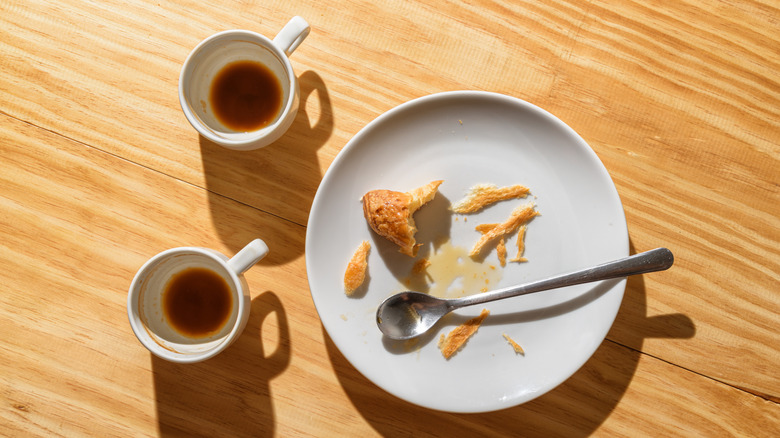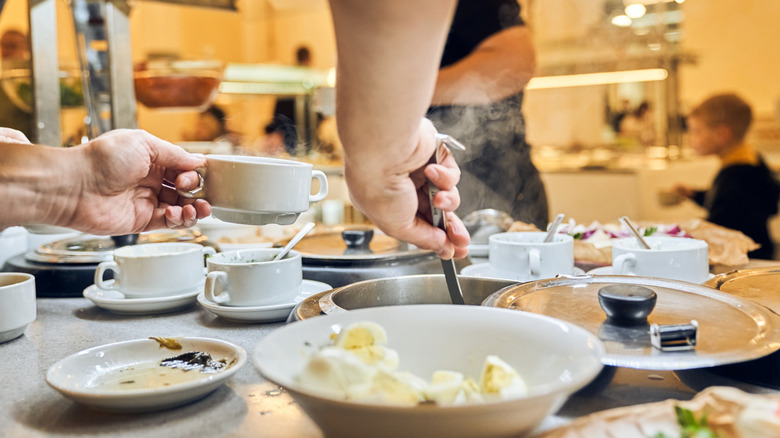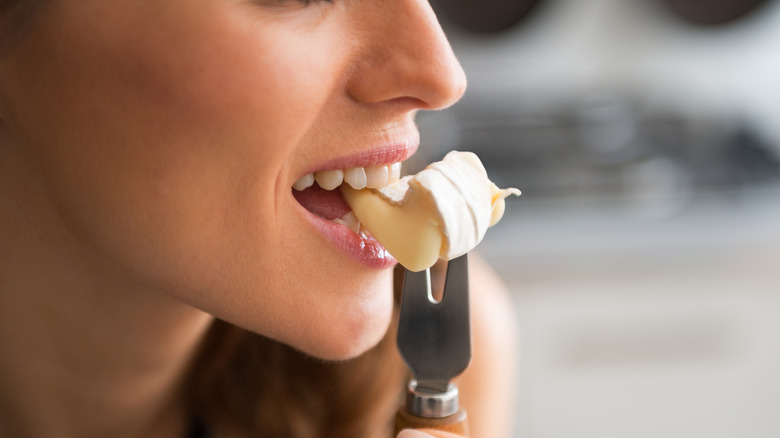13 Buffet Rules Everyone Should Know
Buffets are seemingly straightforward and don't require a lot of rules and regulations — or do they? Though most believe it's perfectly okay to show up to all-you-can-eat buffet chains (or any other type of buffet for that matter) unprepared, the truth is that these dining establishments often require more attention to rules and etiquette than you might imagine. Depending on how popular the buffet is, there could be as many as hundreds of people visiting per day. Without any guidelines in place, buffets are a nightmare waiting to happen, but don't worry; that's what we're here for.
From how you should approach the line to how to properly prepare your plate, we're here to shed light on the buffet etiquette you probably never knew existed. Keep in mind that not every tip mentioned here will apply to every buffet; as always, you'll want to check with each dining establishment to learn more about its specific rules and guidelines.
Avoid heaping mountains of food on your plate
You likely already know this, but it's okay to be modest with your plate when dining at a buffet. Yes, many buffets are technically "all-you-can-eat," but remember, you can always make a second, third, or even fourth trip up if you need to. There's no real reason to pile a plate of food so high that it could potentially topple to the floor. Doing so not only poses a risk to yourself and others, but it can also cause the foods to mix together on your plate, creating an unappetizing, chaotic mess.
Rather than scooping mountains of food onto your dish, it's better to practice proper portioning. Put only the amount of food on your plate you think you'll realistically eat, placing the food side-by-side rather than on top of one another. Not only does this make for a neater, easier-to-carry plate, but your modesty also does everyone else a favor by allowing folks a chance to enjoy certain foods before you gobble them all up. This is especially important at certain times of the day when the buffet is at its busiest; food often runs out quickly, making fair portion sizes even more crucial. After all, buffet food usually gets restocked, and you'll always have the opportunity to revisit the line in the future.
Never load up a new plate before finishing the first
It might seem like we're straining gnats here, but it's usually best practice to finish your first plate before making a trip back to the buffet line. The reason? Leaving food on your plate increases the chances that the grub won't get finished, consequently leading to food waste. And while leaving a small amount of food left on the plate every now and again probably isn't going to do much harm, it's best not to make leaving behind plates of food a routine occurrence.
So what's the best way to avoid this food waste faux pas? Be certain you like an item before it hits your plate. For the foods you're unsure about, add only a small amount to taste-test once you get back to the table; this will help to eliminate the amount of food left over while simultaneously leaving enough food on the buffet line for the folks who do enjoy it.
Always keep serving utensils in their designated location
There are several reasons people resort to switching serving utensils when at a buffet, but even with the best intentions, it's not good etiquette, nor is it safe. With so many people sensitive to certain ingredients, it's important that serving utensils are used only for their intended purpose. Swapping utensils means potentially cross-contaminating foods, making them no longer safe for individuals with sensitivities. Known allergens include peanuts, wheat, fish, and eggs, and exposure to food containing these ingredients can cause life-threatening reactions in some people.
Aside from obvious safety concerns, there's also the issue of mixing flavors; no one wants the spoon used to scoop Jello mixed up with the one used to dish up mashed potatoes. Tired of annoyingly tiny buffet utensils and see a bigger one you'd like to use elsewhere? Resist the temptation and deal with the serving tools given. If you truly need help or there is no utensil available for the food item you want, alert someone who works there rather than exposing others to different allergens, ingredients, or flavors.
Be aware of those around you
See a long line of people awaiting freshly made omelets or customized pancakes at a buffet? As tempting as it may be, don't barge ahead. You likely already know this, but cutting in line is never okay. Being aware of those around you isn't limited to rules about cutting in line, though; even standing too close to others or in the way of small buffet food openings could rub fellow patrons the wrong way.
If you don't know what you want yet, try stepping aside and allowing others through while you make up your mind. Be sure also not to take too long to ponder your next selection or obsess over minor details when building your plate; the people behind you may grow agitated, especially if you do this often, leading to the possibility of unnecessary arguments and confrontations.
The moral of the story? Stay aware of your surroundings and show deference to others for a better dining experience.
Stifle your cough or sneeze whenever possible
We know what you're thinking — who would ever intentionally cough or sneeze on the buffet food in front of them? According to those who work in food retail: plenty of people. And though covering a cough or sneeze with your hand might seem like the right thing to do, the truth is that even this poses a problem. When you cough or sneeze into your hand, you'll spread germs when you go to touch the serving utensils. This exposes everyone to your germs, spreading the love from one person to the next.
Rather than take the risk, it's best to avoid the buffet completely if you're feeling ill. Not quite sick, but have an uncontrollable cough or persistent allergies? Assess the situation to see if a visit to the buffet is truly the best option for you. If you do feel the urge to cough or sneeze as you're serving food, quickly step away from the buffet line and bury your head into your elbow before letting loose. This will lessen the chances of saliva and germs reaching the food and utensils, and your fellow buffet guests will thank you.
Never grab food with your bare hands
Grabbing food with your fingers at a buffet may seem innocent and maybe even natural to some, but given that the buffet line isn't your home kitchen, it's a blunder you don't want to make. Whether your hands are "clean" or not, keeping your fingers off the food is one of the best ways to keep bacteria at bay.
Not only is touching buffet food with your hands unsanitary, but it could pose safety issues even for you. Because buffets often utilize heated trays to keep food at a safe temperature, using your hands to grab food could result in unexpected burns. And because you neglected to use the utensils provided, it's going to be hard to complain or blame the establishment for your injuries.
Rather than take the risk, always opt to use the utensils provided. Yes, they may be awkward to use, but when it comes to keeping buffet food safe for all, the minor inconvenience is well worth it.
Always monitor children closely
Some buffets may have age restrictions, but even if they don't, it's always a good idea to supervise your little ones in line. Though it's usually a wonderful idea to have children practice serving themselves and others, this is best done at home — not at a buffet. Not only do little fingers spread bacteria, but they also run the risk of getting burned or cut after they handle something they shouldn't.
Remember that your child may also need help scooping food and carrying their plate; unnecessary spills can pose a risk to everyone in the restaurant, including your child. As always, observe the rules and age restriction guidelines posted by the buffet, or, if no rules are posted, use your best judgment concerning your child's ability. If your little one isn't tall enough to see over the counter or might have trouble using the utensils provided, it's best that you fix their plate for the time being.
Don't attempt to pack food to go (unless it's allowed, of course)
You've got a plate full of leftover buffet food, but you're absolutely stuffed. Thinking of grabbing a to-go box? Think again. Most buffets won't allow you to take food home, and those that do typically charge for it. There are many reasons buffets do this, but that's not the point. Just know that most buffets won't allow you to pack up, and neither should you try; hoarding food in your purse or setting up some cunning way to sneak it past the staff could easily constitute stealing food from a buffet.
Instead of planning to take your leftover goodies with you, plan on visiting a buffet only to eat until full. To help make this goal a reality, be sure you portion your plate in such a way that satiates your hunger without leaving too much behind. Save room for whatever desserts or treats you plan to dive into at the end of the meal; since you won't have a chance to enjoy them later, you'll want to get your fix before you leave. Remember, some establishments do allow you to take food home; if you're unsure, be sure to ask!
Avoid reusing the same plate
Reusing the same plate at a buffet may seem like a good idea at first; after all, you probably do something similar when going in for seconds at home, so why would dining at a buffet prove any different? The difference is in the transmission of germs to other people, thereby making the idea of reusing your plate while eating at a buffet a common mistake.
Think about it: Your reused plate contains saliva and old food scraps from your previous meal, meaning universally shared tongs, serving spoons, and other utensils will make direct contact with the dirty vessel. As you move through the buffet line, you'll expose your germs to everyone who utilizes the serving utensils thereafter, which isn't exactly our idea of appetizing.
Thus, with all things considered, it's best to opt to grab a new plate at each visit to the buffet. Yes, it'll technically create more dishes for employees, but they won't mind; when it comes to communal dining, safety is paramount.
Always wear proper attire when approaching the buffet
This one's kinda funny, and we'll admit, not everyone is going to love this advice. Whether you're on a cruise ship or perusing the buffet at Golden Corral, it's usually best to cover up when loading your plate.
Wondering how your apparel will affect other people's food? We won't go into explicit detail here, but what we will say is that reaching over shared food with exposed body parts might not be the most hygienic practice. Yes, we're aware that the very nature of cruise ships and other venues often tempts people to commit this common buffet blunder, but it's still best to approach communal dining the same way you would any other restaurant: fully clothed.
That said, there are plenty of other wardrobe issues to be addressed, even when visiting a buffet covered. For example, wearing a shirt or blouse with long, dangling sleeves could prove unsanitary since your clothing could touch the food as you prep your plate. The same is true for any other loose or ill-fitting clothing or accessory items, meaning that careful assessment of your attire before your next trip to a buffet is crucial.
Don't try to evade the sneeze guard
Sneeze guards are there for a reason, though not for sneezing, as some may believe. But there's another aspect to the glass food guards that people often miss; you shouldn't attempt to go under it, either. Though you may find certain buffet foods pushed way in the back that may require some level of contortion to reach, you should never extend the full length of your arm and head under the glass barrier. Doing so puts the food at risk of compromise as hair, fabric from clothing, saliva, and more could make their way into the food, leading to an unsanitary dining environment.
With this in mind, if you approach a buffet and realize you'll need to force your body under the glass barrier to get to the food, it's best to ask for help. Locate an employee or buffet worker to assist you, and be willing to wait as the staff either rearranges food items or cooks them up fresh. In the meantime, grab other items to chomp on; though waiting is less convenient, it's better in terms of etiquette and food safety for sure.
Never eat in line
Taking a nibble or two of food certainly sounds like a convenient option while waiting, but eating food while in line at a buffet is an etiquette faux pas you don't want to make. So, what's the big deal? Like most other blunders on the list, eating in line exposes people to unwanted germs. As you chew, saliva from your mouth can make its way onto the plates of others and even onto exposed food on the buffet line.
Just imagine if everyone ate in line. With bits of chewed food spewing all over the place, it certainly wouldn't be the most appetizing sight to see. In addition to not chewing food as you wait, we also encourage you to never taste test food before putting it onto your plate. The action of touching the food with your bare hands or, gasp, even using shared utensils to bring food to your mouth is wrong on so many levels. Though gratifying, resisting the temptation to eat in line will lead to a cleaner buffet environment for all.
Try not to eyeball the food before hopping in line
Tempted to take a stroll around the buffet to see what "looks good" before actually digging in? If so, we need to talk. Though a quick preview might help you more readily decide what to eat once you are ready to grab a plate, the aimless meandering might cause people to think you're in line, or worse, that you're attempting to cut in front of them. The constant pacing, leaning over to look, and standing in the way tends to make you a general nuisance, as you block the space for people who actually want to make a food selection.
Rather than taking a preview, it's better to simply grab a plate, hop in line, and observe the buffet when it's your turn. If you truly don't know what you want to eat, either take a seat or stand at a distance to observe if you must; just be sure not to stand in the way of other hungry guests who already have their minds made up.
